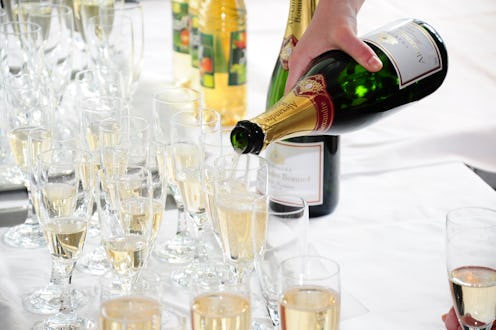Life
Your Guide To Becoming A Sparkling Wine Expert

It's the holiday season, which means that it's also sparkling wine season. Maybe you’re trying to pick out a nice bottle of bubbles to take as a host gift, maybe you’ve just been scarred by a college experience drinking too much Andre, or maybe you've just finally hit the point in your life when you don't have to say "whatever's cheapest," but sometimes knowing how to pick out champagne and sparkling wine can be daunting enough to make you just grab for the closest bottle. So how do you avoid champagne panic? Read on to educate yourself on this seasonally appropriate sparkler, and you’ll be popping bottles in no time.
There are a few different types of sparkling wine that you are likely to encounter on a menu or at the store, namely champagne, prosecco, cava, and American-made sparkling wine. Don't let the wide range of options scare you, though. Here’s a more in-depth primer on the differences between them, but unless you are going to be hanging out with a bunch of master sommeliers, you can probably grab a bottle in pretty much any style, and no one will know the difference. My tips below should help you find something you like, no matter what your preference or budget.
History
Funnily enough, the occasional occurrence of accidentally sparkling wine back in the Middle Ages was considered a flaw, not a feature. And because of the added pressure from the carbon dioxide (which is what those bubbles are), the sparkling bottles could even be dangerous, as they were much more volatile and prone to explosion. Luckily, in the 16th century, the British decided that there was something to this whole bubbles thing, and developed many of the features we still use for sparkling wine production today, including sturdier bottles and cork stoppers.
Where Is It Grown?
Um, pretty much everywhere. While champagne can technically only come from the Champagne region of France (here’s an explanation of how that works), countries all over the world produce sparkling wine, including the United States, South America, and Australia. While some have their own specialities, like prosecco in Italy, or cava in Spain, others produce sparkling wines in the style of champagne, just without the official name.
What To Look For
When choosing any sparkling wine, Pauline Lhote, the chief winemaker for Chandon, tells Bustle that you can tell a lot about your wine before you even taste it: “[With bubbles,] the smaller the better. Small bubbles usually mean that the wine was made in the traditional method, the same one used in the Champagne region of France...Then, the aroma should be fresh and clean, it should not smell oxidized, or like it has been exposed to too much air. An example of this would be how a fresh slice of apple smells versus how it would smell if it had been sitting out and turned brown.”
Suggested Bottles
I know that just buying straight champagne isn’t always going to work for everyone, especially people on limited budgets. Don’t stress. I promise that, whether it’s prosecco or champagne, no one will complain when you hand them a glass.
For under $15, you can’t go wrong with La Marca Prosecco ($13.99); it’s bright and crisp, with apple and citrus notes. For some mid-range bubbles that also make great host gifts, since they have pretty holiday packaging right now, Chandon Blanc de Noirs ($18.99) is perfect, which is dry, warm, and has hints of toast and orange peel. And for a treat-yo-self, honest-to-goodness champagne, the Nicolas Feuillatte Brut Reserve ($34.99) also has gorgeous bottles, along with a delicate, lightly spicy finish.
What To Serve It With
Everything! Sparkling wine is a favorite of food industry veterans everywhere for a reason: it complements everything from French fries (seriously) to oysters. Lhote also suggests the more unusual combination of sparkling rosé with a piece of milk chocolate. For a light meal that’s guaranteed to taste amazing with your bubbles, try these grilled oysters with prosciutto and mignonette.
Another great thing about sparkling wine is that it’s just as delicious in a cocktail as it is on its own. If you find yourself with a surplus, try it in a sparkling celery-thyme cocktail, or a classic Aperol Spritz.
Looking for more holiday cheer? Check out Bustle on YouTube.
Images: Flickr/Toni Blay, Al, L.C. Nøttaasen; Adventures In Cooking